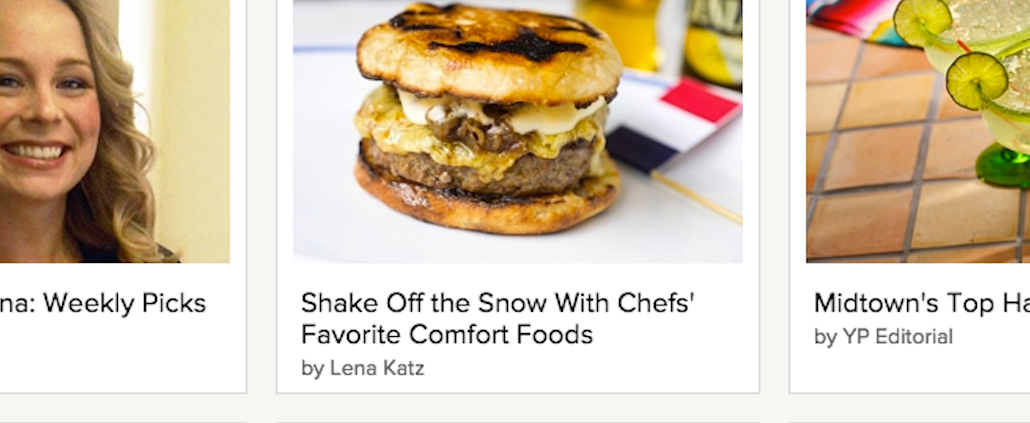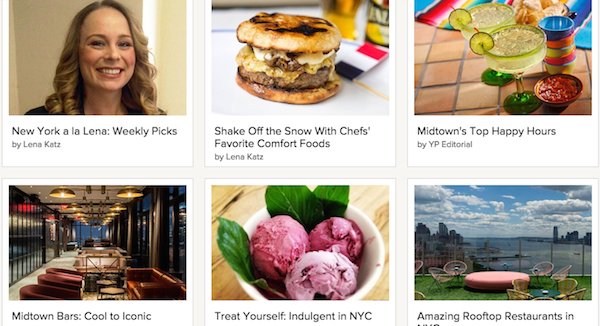
If you’re like most people, you probably haven’t thumbed through a phone book lately. Online search is where most of our fingers do the walking now.
To stay relevant with young consumers, the Yellow Pages renamed itself YP in 2012 and prioritized its digital properties. Now, it’s taking a familiar page from the brand playbook and launching a content strategy.
To that end, a new YP marketing campaign launches today called “Make Every Day Local,” featuring videos of news, sports and TV personalities including ESPN’s Hannah Storm and reality stars Bill and Giuliana Rancic talking about their favorite hometown businesses.
YP has also contracted with five local bloggers to write about food, which is YP’s most-searched category, with plans to add more bloggers in other business categories. They’re supplemented by a small in-house editorial team of people who write bite-sized reviews of local businesses, which are grouped into recommended collections aimed at people searching the site.
The platform is encouraging visitors to the site to post comments and tweet about local businesses as well. The content will reside on YP’s site, its app and a microsite, makeeverydaylocal.com. YP will also push it out on YouTube and social networks, where YP has a diminutive presence, with 12,500 Twitter followers and 531,755 Facebook likes.
YP is trying to grow awareness with millennials, many of whom may have no connection to the brand. While the company expects to derive more than 50 percent of its ad revenue from digital this year, its name is still closely associated with those thick yellow directories. Allison Checchi, CMO of YP, said the content is designed to increase people’s engagement with the brand, which she’ll track by looking at metrics like repeat visits, change in awareness and app downloads.
“Content has to be meaningful to what your product does,” Checchi said. “For us, the experience is, how do I select a business? So that’s what our content needs to reinforce.”
With an editorial team and site that’s regularly fed by bloggers and user-generated content, YP is reminiscent of other brands, such as Adobe and GE, that are producing editorial content on an ongoing basis. Checchi stopped short of calling YP a publisher, though. “That’s not our core business,” she said. “You could say we’re a publisher of sorts. But I would like to think of ourselves as a conduit for people who publish. So a platform. And any consumer.”
Surrounding its local business results with editorial content can be a way for YP to stand out in a commoditized category, and using influencers can help YP tap into millennials, for whom the definition of what an “expert” is is broadening, said Andy Seibert, managing partner of Imprint, the content lab at marketing firm Sullivan NYC.
But by entering the content fray, YP is going up against established publishers such as New York magazine and Zagat and newer platforms like Eater and Yelp. Much of YP’s content has a generic feel, such as Midtown’s Top Happy Hours that helpfully reveals that “midtown is not the place to save big bucks.”
As for its “influencers,” they hardly have giant social footprints, considering their market sizes. In New York, there’s Lena Katz, with just 1,670 followers on Instagram, while the San Francisco blogger Amy Sherman has 19,600 Twitter followers.
Seibert said YP could use a stronger point of view if it’s going to go up against such a big competitive set. “The quality of the content really has to be high,” he said. “Some of their pieces could use a little more attention. One of the pieces was about intellectual stimulation; I felt like I needed more to compete with Time Out [New York]. It’s got to be about the relevancy of their recommendations.”
More in Media

Media Briefing: Publishers who bet on events and franchises this year are reaping the rewards
Tentpole events and franchises are helping publishers lock in advertising revenue.

With Firefly Image 3, Adobe aims to integrate more AI tools for various apps
New tools let people make images in seconds, create image backgrounds, replacing parts of an image and use reference images to create with AI.

Publishers revamp their newsletter offerings to engage audiences amid threat of AI and declining referral traffic
Publishers like Axios, Eater, the Guardian, theSkimm and Snopes are either growing or revamping their newsletter offerings to engage audiences as a wave of generative AI advancements increases the need for original content and referral traffic declines push publishers to find alternative ways to reach readers.






